mobile Ansicht, to the English Version tap the flag
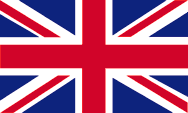

- Sultanat Oman
- absolute Monarchie
- Eigenbezeichnung: Saltanat 'Oman
- frühere Bezeichnung: Maskat und Oman
• Flaggen
• historische Flaggen
• Bedeutung/Ursprung der Flagge
• Wappen
• Bedeutung/Ursprung des Wappens
• Flugzeugkokarde
• Landkarte
• Zahlen und Fakten
• Geschichte
• Ursprung des Landesnamens
• regionale historische Flaggen:
- Imamat Oman
- Dhofar
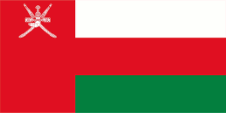
seit 1995,
National- und Handelsflagge,
Seitenverhältnis = 1:2,
Quelle, nach: Flags of the World,
using commons.wikimedia.org



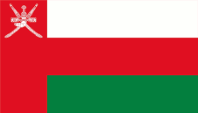
seit 1995,
Staatsflagge,
Seitenverhältnis = 4:7,
Quelle, nach: Flags of the World,
using commons.wikimedia.org





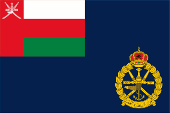
seit 1995(?),
Marineflagge,
Seitenverhältnis = 2:3,
Quelle, nach: Flags of the World,
using commons.wikimedia.org



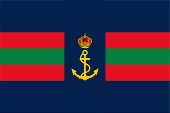
seit 1995(?),
Gösch,
Seitenverhältnis = 2:3,
Quelle, nach: Flags of the World,
using commons.wikimedia.org



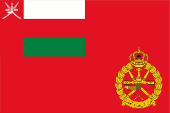
seit 1995(?),
Flagge des Heeres,
Seitenverhältnis = 2:3,
Quelle, nach: Wikipedia (EN),
using commons.wikimedia.org



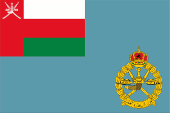
seit 1995(?),
Flagge der Luftwaffe,
Seitenverhältnis = 2:3,
Quelle, nach: Wikipedia (EN),
using commons.wikimedia.org



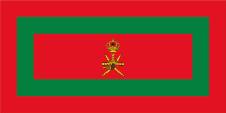
seit 1995(?),
Königliche Flagge (Flagge des Sultans),
Seitenverhältnis = 1:2,
Quelle, nach: Flags of the World,
using commons.wikimedia.org





1913–1954,
Flagge des Imamats Oman,
Quelle, nach: Wikipedia (EN)



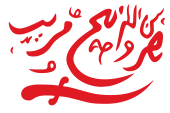
1954–1957,
Flagge des Imamats Oman,
Quelle, nach: Wikipedia (EN),
BlinxTheKitty, Public domain, via Wikimedia Commons




1856–1970,
Flagge des Sultanats Maskat und Oman,
Quelle, nach: Wikipedia (EN)



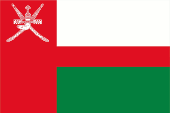
1970–1995,
National- und Handelsflagge von Oman,
Seitenverhältnis – ratio = 2:3,
Quelle, nach: Wikipedia (EN),
using commons.wikimedia.org



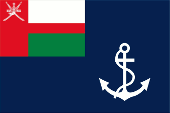
1970–1995,
Marineflagge von Oman,
Seitenverhältnis – ratio = 2:3,
Quelle, nach: Flags of the World, Flaggen und Wappen



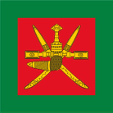
bis 1995,
zweifelhaft,
Flagge des Sultans von Oman,
Quelle, nach: unbekannt/unknown,
using commons.wikimedia.org




Bedeutung/Ursprung der Flagge
Die heutige Flagge Omans wurde in ihren Grundzügen am 17.12.1970 offiziell eingeführt, und in den Jahren 1985 (Änderungen am Emblem) und 1995 (Verbreiterung des roten Mittelstreifens) leicht abgeändert. Sie besteht aus drei waagerechten Streifen in Weiß, Rot und Grün, und einem ein Drittel breiten senkrechten roten Streifen am Mast. Im Obereck, im senkrechten roten Streifen, das Staatsemblem (Emblem der Saidi-Dynastie) in Weiß. Bis 1970 war die Flagge einfarbig rot. Rot ist die Farbe der charidschitischen Mohammedaner. Seit 1970 trägt die Flagge den weißen und den grünen Streifen, als Symbolfarben von Frieden und Fruchtbarkeit. In einer anderen Interpretation steht das weiße Feld auch für das Imamat Oman, welches zwischen 1913 und 1957 bestand. Das Grün soll auch für die fruchtbare Provinz Dhofar im Süden des Landes stehen, bzw. auch für den Dschebel Akhdar, ein grünes, fruchtbares Gebirge im Norden des Landes. Das Rot soll auch an die siegreichen Kämpfe des Landes in der Vergangenheit erinnern. Im Jahre 1995 wurde wahrscheinlich nicht nur die Nationalflagge überarbeitet, es wurden in diesem Jahr wahrscheinlich auch neue Flaggen für die Teilstreitkräfte eingeführt, eine Kriegsschiffsgösch und wahrscheinlich auch eine neue persönliche Standarte für den Sultan. Die Farben Rot und Grün scheinen nicht besonders spezifiziert oder genau festgelegt zu sein.
Quelle:
Die Welt der Flaggen,
Flaggen Wappen Hymnen,
Wikipedia (EN)

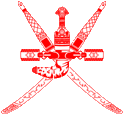
Wappen von Oman,
Quelle: Corel Draw 4

Das Staatsemblem des Oman zeigt einen Khanjar (arabischer Dolch mit gebogener Scheide) vor zwei gekreuzten Krummschwertern, belegt mit einem Wehrgehänge. Dieses Symbol findet sich seit 1940 auf Münzen, seit 1966 auch auf Briefmarken des Sultanats Oman. Es ist das Abzeichen der Abu Saids, der omanischen Herrscherfamilie.
Quelle:
Flaggen Wappen Hymnen,
Wikipedia (EN)


seit 1985,
Flugzeugkokarde,
Quelle, nach: Wikipedia (EN)
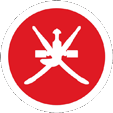
1970–1985,
Flugzeugkokarde,
Quelle, nach: Wikipedia (EN)

Lage:
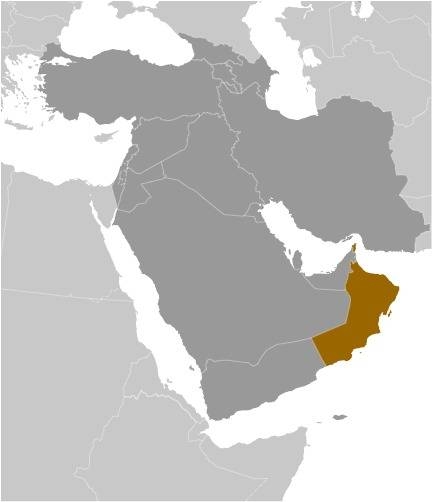
Quelle: CIA World Factbook
Landkarte des Landes:
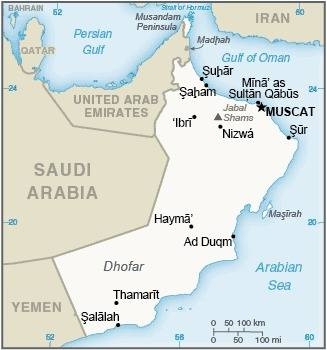
Quelle: CIA World Factbook

Fläche: 309.500 km²
Einwohner: 4.800.000 (2020), 54% Araber, 30% Inder, Pakistani, Bengali, Singhalesen
Religionen: 86% Moslems, 6,5% Christen, 5,5% Hindus
Bevölkerungsdichte: 15 Ew./km²
Hauptstadt: Maskat (Masqat), 635.279 Ew. (2020?)
Amtssprache: Arabisch
sonstige Sprachen: Englisch, Baluchi, Swahili, Urdu
Währung: 1 Oman-Rial (OMR, OR, RO) = 1 000 Baizas
Zeitzone: MEZ + 3 h
Quelle:
Wikipedia (D),
CIA World Factbook

2700–2000 v.Chr. · Umm-an-Nahr-Kultur, Land Makan im Norden heutigen Oman
1800 v.Chr. · Niedergang der Umm-an-Nahr-Kultur
500 v.Chr. · persische Eroberung
2. Jhd. n.Chr. · Einwanderung des Stammes der Azd aus Jemen, Gründung des Reiches der Azd unter der Julanda-Dynastie
ab 643 n.Chr. · Islamisierung
7.–8. Jhd. n.Chr. · Niedergang des Reiches der Azd, Unterwerfung durch die Perser des Sassanidenreiches, im 8. Jhd. Ausbreitung der Lehre der Charidschiten
751 · Wahl des ersten Imams (Führer) der Charidschiten
8.–10. Jhd. · Blütezeit als Handelsdrehscheibe
1065–1140 · Invasion der Seldschuken
1256 · Eroberung duch persische Truppen
1507 · Landung der Portugiesen, Eroberung von Maskat, Sur und Sohar
1650 · Abzug der Portugiesen, allmähliche Ausbreitung des Reiches Oman entlang der afrikanischen Ostküste nach Süden
1720–1746 · Erbfolgekrieg
1746 (auch 1741? oder 1744?) · Machtübernahme durch die bis heute regierenden Sultane der Said-Dynastie
ca. 1800 bis 1850 · Verlagerung des wirtschaftlichen Schwerpunktes nach Sansibar
1824 · Verlagerung der Residenz des Sultans nach Sansibar
1829 · das Land Dhofar wird von Oman abhängig
1856 · Tod des Sultans, in Folge britischem Drucks Teilung des Landes (Teilung der Dynastie in zwei Linien) in das Sultanat Oman und das Sultanat Sansibar, wirtschaftlicher Niedergang Omans
1879 · das Land Dhofar wird von Oman annektiert
1885–1886 · Aufstand in Dhofar
1891 · das Sultanat Oman wird britisches Protektorat
1891–1913 · weiterer wirtschaftlicher Niedergang, Isolationspolitik der Sultane
1913 · Wahl eines Imam (Salim Ibn Rashid al-Kharusi) durch enttäuschte Charidschiten (Ibaditen), Proklamation des Imamats Oman mit der Hauptstadt Nizwa, Bürgerkrieg
1920 · Tod von Imam Salim Ibn Rashid al-Kharusi, Friedensvertrag zwischen seinem Nachfolger Abd Allah al-Khalili al-Kharusi und dem Sultan von Oman, das Sultanat Oman wird faktisch geteilt und nennt sich nun Sultanat Maskat und Oman (Maskat ist der Sitz des Sultans von Oman, Nizwa ist der Sitz des Imams von Oman)
1954 · Tod des Imams Abd Allah al-Khalili al-Kharusi, Wahl des Ghalib Ibn Ali al-Hinawi zum neuen Imam, das Imamat versucht nun mit Unterstützung von Ägypten und Saudi-Arabien die völlige Unabhängigkeit zu erreichen, Bürgerkrieg
1957 · Eroberung von Nizwa durch omanische und britische Truppen, Sturz des Imams Abd Allah al-Khalili al-Kharusi
1959 · Kapitulation der letzten Truppen des Imamats Oman, Rückbenennung des Landes von "Sultanat Maskat und Oman" in "Sultanat Oman"
1962 · Erste Ölfunde
09.06.1965 · Beginn des bewaffneten Kampfes der Dhofar Liberation Front (DLF)
März 1975 · die Dhofar-Rebellen schließen einen Friedensvertrag mit Oman
1979 · erneute Kämpfe in Dhofar
1991 · Ernennung eines Konsultativrats
November 1996 · erste Verfassung
1997 · Frauenwahlrecht
1998 · Oman beschließt militärische Zusammenarbeit mit dem Iran
Mai 1999 · Grenzvertrag mit den Vereinigten Arabischen Emiraten
Source: 1.) DB Sonderband: Wikipedia - Frühjahr 2005, 2.) World Statesmen, 3.) Wikipedia (DE)

Der Name des Landes wurde schon als "Omana" bei Plinius dem Älteren erwähnt und auch Ptolemäus erwähnt ein "Omanon". Der Name lässt sich auch aus dem Arabischen ableiten, aus dem Wort "aamen" oder "amoun", was eine sesshafte Bevölkerung bezeichnet. Auch gibt es Namen von historischen Persönlichkeiten, die als mythische Gründer herangezogen werden: Oman bin Ibrahim al-Khalil, Oman bin Siba' bin Yaghthan bin Ibrahim, Oman bin Qahtan.
Source: Wikipedia (EN)

- 1913–1957 Teilstaat innerhalb Omans

1913–1954,
Flagge des Imamats Oman,
Quelle, nach: Wikipedia (EN)




1954–1957,
Flagge des Imamats Oman,
Quelle, nach: Wikipedia (EN),
BlinxTheKitty, Public domain, via Wikimedia Commons



Das Sultanat Oman war seit 1913 zweigeteilt. In Maskat residierte der Sultan und in Nizwa seit 1913 der Imam von Oman. Das Imamat Oman unterstand nur formal dem Sultan von Maskat und wollte sich 1954 von Großbritannien und Maskat lösen und die Unabhängigkeit erreichen. Nach einem Bürgerkrieg wurde das Imamat 1959 beendet und Maskat einverleibt. Das Imamat Oman verwendete eine einfarbige weiße Flagge. Die Farbe Weiß steht in der islamisch-arabischen Welt für die Dynastie der Omajiaden, eine Kalifendynastie, die auf den fünften Kalifen Moawija I. zurückgeht.

- separatistischer Staat
- 1971–1975 von Oman abgetrennt
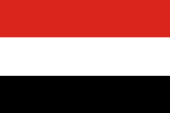
1965–1975,
Nationalflagge von Dhofar,
Quelle, nach: World Statesmen



Der an Jemen grenzende Landesteil Dhofar (Zufar, Dhufar) war erst 1879 vom Sultanat Oman annektiert worden. Gegen die omanische Herrschaft gab es immer wieder Aufstände. Im Jahre 1964 brach dann ein offener Bürgerkrieg aus. Bis 1970 war das ganze Land in der Hand der Separatisten und 1971 wurde eine eigene Regierung eingerichtet. Südjemen leistete massive Unterstützung. Bis 1975 konnte sich Dhofar halten. Nach dem Waffenstillstand vom März 1975 wurde der bewaffnete Kampf fast ganz aufgegeben. Dhofar verwendete eine Flagge, die derjenigen der Nationalen Befreiungsfront im Südjemen sehr stark ähnelte. Zeitweise wurden die Farben auch umgedreht oder arabische Schiftzeichen im weißen Streifen eingefügt.


![]()



















































